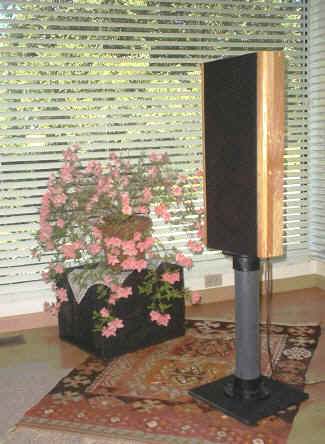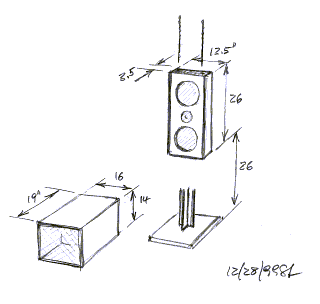|

| Build-Your-Own
| Main Panel | Dipole Woofer | Crossover/EQ
| Supplies |
| System Test | Design Models | Prototypes
| Active Filters | Surround
| FAQ
| Distortion Test | Phase
Distortion | Phase Distortion 2 | Diffraction
| SPL Limit |
The PHOENIX project from the year 2000
is obsolete and no longer supported. The information on the following pages is
an introduction to open-baffle loudspeaker systems and highly educational. The
PHOENIX evolved via the ORION into the LX521.4.
Build your own
open-baffle loudspeaker system

In the pages listed below you will find information for
building open-baffle loudspeakers using conventional cone type dynamic drivers.
As an example and as an enticement to you, I provide you with design information for
the PHOENIX, a loudspeaker
system of the highest sonic performance, true to the
original , FAQ22 .
The speaker evolved over a number of years and represents
a departure from my earlier approach to system design in Ref.12.
At that time I had not sufficiently understood the influence of the room upon
the reproduced sound at low frequencies. The speaker is a refinement of the compact
dipole in Ref.
2, a 3-way system with line-level crossover and equalization circuitry ahead of
the power amplifiers.
The loudspeaker system is intended for rooms in the 250-600 ft2
(22-55 m2) foot print range, when using two-channel playback.

Each playback channel consist of:
1 - A panel with two 8 inch drivers and a 1 inch dome tweeter.
It is an open baffle design and the unit might mount on a speaker stand or hang
on two thin ropes from the ceiling to bring the tweeter to ear height or
slightly above. The panel should have a distance of at least
2.5 ft (0.75 m) to any adjacent wall.
2 - A woofer with two 12
inch drivers arranged for dipole radiation. The woofer should be positioned at
the same distance from the listening place as is the panel, and preferably along
the side wall, for optimal summation of sound outputs in the crossover frequency
range, and minimal excitation of room modes.
3 - An active crossover/equalizer for three power
amplifiers of 50-200 W each. The amplifiers must have identical voltage gains,
<0.1% distortion and >20 damping factor.
I have kept the wood working aspects of the design as
simple as possible without compromising the
sound, and a blank circuit board for the crossover/eq electronics is available. This
still leaves to you the details of how to mount the panels, load and package the
circuit board, and refine the looks of the speaker. I assume you have
available at least a few electronic measurement tools, like a signal source and
an oscilloscope, and maybe a loudspeaker measurement software package with a
sound card and a measurement microphone. Should you have no access to test
equipment, then you might want to have me check your
assembled printed circuit boards for a nominal fee. No acoustic tests are
necessary, other than for driver polarity with a battery.
Since
this is an open baffle, bi-directionally radiating dipole speaker, it is free of
the typical box coloration and provides the most natural bass reproduction due
to minimal excitation of room modes. Also, as a fully active system and with a
superb - but costly - driver complement, it will be capable of extremely dynamic
and articulate sound reproduction. It is definitely at the leading edge of
speaker-room-listener system design.
The PHOENIX system challenges most other speakers for
accuracy of sound reproduction. The theory behind the design may also be a challenge
to your understanding of acoustics, electronics and loudspeaker construction.
Building the speaker, though, should be straight forward when you follow the
detailed information provided and will guarantee a successful outcome.
This is meant to be a DIY project for the music loving
hobbyist. Should you consider using part or the whole of my design for commercial
purposes, then
contact me for permission and contractual agreement before using any of the
information provided.
-----------------------------------------------

| Build-Your-Own
| Main Panel | Dipole Woofer | Crossover/EQ
| Supplies |
| System Test | Design Models | Prototypes
| Active Filters | Surround
| FAQ |
|